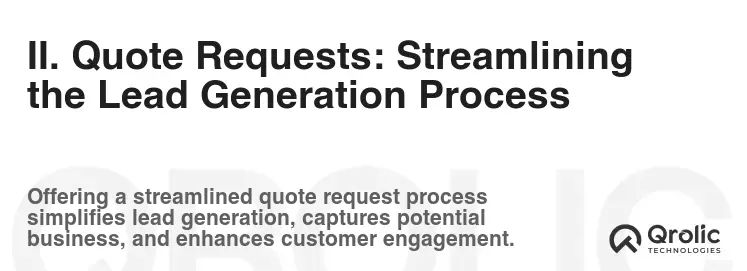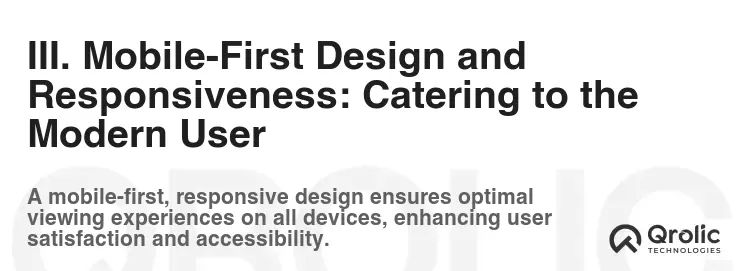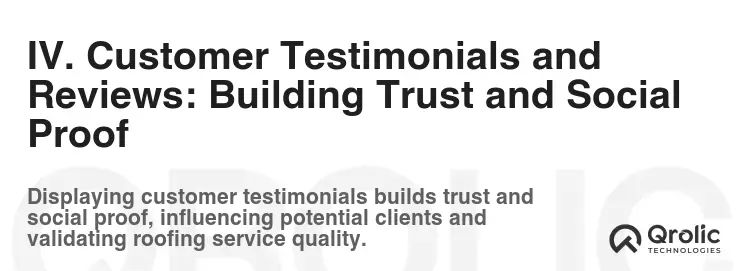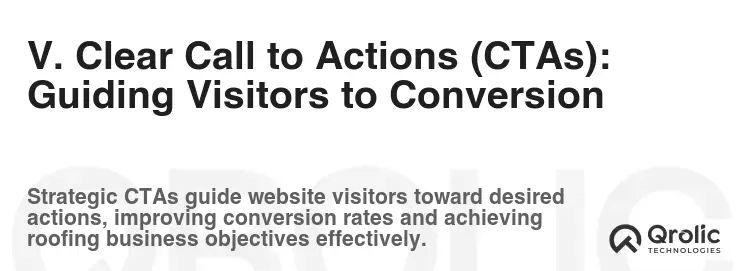A roofing contractor’s website isn’t just an online brochure; it’s a 24/7 sales representative, lead generator, and reputation manager. In today’s digital age, a professional, user-friendly, and feature-rich website is non-negotiable for success. This article dives deep into the must-have website features that will elevate your roofing business and attract more customers.
Quick Summary:
- Showcase your work with a stunning project gallery.
- Make it easy for customers to request a quote.
- Build trust with testimonials and mobile-first design.
Table of Contents
- I. Project Gallery: Showcasing Your Roofing Expertise
- A. Why a Project Gallery is Essential
- B. Components of a High-Impact Project Gallery
- C. Best Practices for Project Gallery Management
- II. Quote Requests: Streamlining the Lead Generation Process
- A. Why Quote Requests are Crucial
- B. Essential Elements of an Effective Quote Request Form
- C. Optimizing the Quote Request Process
- III. Mobile-First Design and Responsiveness: Catering to the Modern User
- A. The Importance of Mobile-First Design
- B. Key Elements of a Mobile-Friendly Website
- C. Testing and Optimization for Mobile
- IV. Customer Testimonials and Reviews: Building Trust and Social Proof
- A. Why Testimonials and Reviews Matter
- B. Strategies for Collecting Testimonials and Reviews
- C. Displaying Testimonials and Reviews on Your Website
- V. Clear Call to Actions (CTAs): Guiding Visitors to Conversion
- A. Why CTAs are Crucial
- B. Best Practices for Creating Effective CTAs
- C. Types of CTAs for Roofing Contractors
- VI. About Us Page: Telling Your Story and Building Connection
- A. Why an “About Us” Page is Important
- B. Essential Elements of an Effective “About Us” Page
- C. Telling Your Story Authentically
- VII. Blog and Content Marketing: Establishing Authority and Driving Traffic
- A. Why Content Marketing is Essential
- B. Content Ideas for Roofing Contractors
- C. Content Optimization for SEO
- VIII. Security: Protecting Your Website and Customer Data
- A. Why Website Security Matters
- B. Essential Security Measures
- C. Monitoring and Maintenance
- IX. Qrolic Technologies: Your Partner in Building a Powerful Online Presence
- A. Qrolic Technologies Services
- B. Why Choose Qrolic Technologies?
- X. Analytics and Tracking: Measuring Success and Making Data-Driven Decisions
- A. Why Analytics and Tracking are Crucial
- B. Essential Analytics Tools
- C. Key Metrics to Track
I. Project Gallery: Showcasing Your Roofing Expertise

A picture is worth a thousand words, and in the roofing industry, this couldn’t be truer. A well-curated project gallery is the cornerstone of your website, demonstrating your skills, experience, and the quality of your workmanship.
A. Why a Project Gallery is Essential
- Visual Proof of Quality: Potential clients want to see the finished product. High-quality images of your completed roofing projects provide visual proof that you deliver on your promises.
- Building Trust and Credibility: A comprehensive gallery showcases your versatility and expertise. Seeing a variety of roof types, materials, and project complexities builds trust with potential customers.
- Inspiring Ideas and Visualizing Possibilities: Your gallery can spark ideas for clients who may not know what they want. Showcasing different roofing styles and materials helps them visualize the possibilities for their own homes.
- Attracting Local Customers: Optimize your images with location-specific keywords (e.g., “roof replacement in [City]”) to attract local customers searching for roofing services in their area.
- Differentiating Yourself from Competitors: A professional and well-maintained gallery instantly sets you apart from competitors with outdated or poorly designed websites.
B. Components of a High-Impact Project Gallery
High-Quality Photography: Invest in professional-grade photography to capture the details of your work. Ensure images are well-lit, in focus, and showcase the craftsmanship.
- Before-and-After Shots: Showcase the transformation you bring to properties. These visually demonstrate the impact of your work.
- Close-Ups of Details: Highlight specific features like intricate flashing, precise shingle alignment, or the quality of materials used.
- Wide-Angle Shots: Provide context and show the entire roof in relation to the property.
Detailed Project Descriptions: Don’t just post pictures; tell a story. Include details such as:
- Roofing Material Used: Specify the type of shingles, metal roofing, or other materials employed.
- Project Location: Indicate the city or neighborhood where the project was completed (for local SEO).
- Challenges Overcome: Highlight any unique challenges faced and how you successfully addressed them.
- Client Testimonials: Include quotes from satisfied clients to reinforce the positive impact of your work.
-
Categorization and Filtering: Organize your gallery by roof type (e.g., asphalt shingle, metal, tile), service type (e.g., repair, replacement, installation), or project location to help visitors easily find what they’re looking for.
-
Mobile Optimization: Ensure your gallery is fully responsive and displays correctly on all devices, including smartphones and tablets. Mobile-friendliness is crucial for attracting on-the-go users.
-
Fast Loading Speed: Optimize images for web use to ensure quick loading times. slow loading speeds can lead to high bounce rates and lost leads.
C. Best Practices for Project Gallery Management
-
Regular Updates: Keep your gallery fresh by adding new projects regularly. This demonstrates that you’re actively working and staying up-to-date with current trends.
-
Image Optimization for SEO: Use descriptive file names and alt tags for all images. Include relevant keywords like “roof repair,” “roof replacement,” and your location.
-
Watermarking: Protect your images from unauthorized use by adding a watermark with your company logo and website address.
-
Social Media Integration: Share your project gallery on social media platforms to expand your reach and drive traffic back to your website.
-
Request Client Permission: Always obtain permission from clients before featuring their properties in your project gallery. This demonstrates professionalism and respect for privacy.
II. Quote Requests: Streamlining the Lead Generation Process

Making it easy for potential customers to request a quote is paramount to converting website visitors into paying clients. A well-designed quote request form can significantly improve your lead generation efforts.
A. Why Quote Requests are Crucial
- Capturing Qualified Leads: A quote request form allows you to gather essential information from potential clients, helping you determine if they’re a good fit for your services.
- Simplifying the Initial Contact: It provides a convenient and non-intrusive way for customers to initiate contact with your company.
- Improving Response Time: Having the necessary information upfront allows you to provide more accurate and timely quotes.
- Tracking Lead Generation Efforts: Analyzing the data collected through quote requests helps you understand which marketing channels are most effective.
- Increasing Conversion Rates: A streamlined quote request process can significantly increase the likelihood of converting website visitors into paying clients.
B. Essential Elements of an Effective Quote Request Form
-
Clear and Concise Language: Use simple, easy-to-understand language. Avoid technical jargon that may confuse or intimidate potential customers.
-
Mobile-Friendly Design: Ensure the form is fully responsive and easy to fill out on all devices.
Minimal Fields: Only ask for the essential information needed to provide an accurate quote. Keep the form short and to the point to minimize friction. Essential fields include:
- Name: Full name of the contact person.
- Email Address: For sending the quote and follow-up communication.
- Phone Number: For direct communication and clarification.
- Property Address: To assess the scope of the project.
- Type of Service Needed: (e.g., repair, replacement, installation, inspection). Provide a dropdown menu for easy selection.
- Brief Description of the Issue: Allow customers to describe the problem or project in their own words.
- Preferred Contact Method: (e.g., email, phone).
-
File Upload Option: Allow customers to upload photos or documents related to their roofing project. This can provide valuable context and help you provide a more accurate quote.
-
Captcha or Anti-Spam Measures: Protect your form from spam submissions with a captcha or other anti-spam technology.
-
Privacy Policy Link: Include a link to your privacy policy to reassure customers that their information will be kept confidential.
-
Clear Call to Action: Use a compelling call to action button, such as “Get a Free Quote,” “Request a Quote Now,” or “Get Your Personalized Estimate.”
C. Optimizing the Quote Request Process
-
Prominent Placement: Make the quote request form easily accessible on every page of your website, especially on the homepage, service pages, and contact page.
-
Thank You Page: Redirect users to a thank you page after submitting the form. This confirms that their request has been received and sets expectations for follow-up.
-
Automated Email Confirmation: Send an automated email confirmation to the customer acknowledging receipt of their quote request. Include an estimated timeframe for when they can expect to receive the quote.
-
Fast Response Time: Respond to quote requests promptly, ideally within 24-48 hours. This demonstrates responsiveness and professionalism.
-
Follow-Up System: Implement a system for following up with potential clients who have requested quotes. This can include phone calls, emails, or personalized messages.
-
Track and Analyze Data: Monitor the number of quote requests received and track conversion rates. This data can help you identify areas for improvement and optimize your lead generation efforts.
III. Mobile-First Design and Responsiveness: Catering to the Modern User

In today’s mobile-dominated world, a website that isn’t optimized for mobile devices is essentially invisible to a significant portion of potential customers.
A. The Importance of Mobile-First Design
- Majority of Web Traffic is Mobile: Studies consistently show that a large percentage of website traffic originates from mobile devices.
- Google Prioritizes Mobile-Friendly Sites: Google uses mobile-first indexing, meaning it primarily uses the mobile version of your website for indexing and ranking.
- Improved User Experience: A mobile-friendly website provides a seamless and enjoyable experience for users on smartphones and tablets.
- Increased Engagement and Conversions: A positive mobile experience leads to increased engagement and higher conversion rates.
- Competitive Advantage: A mobile-optimized website sets you apart from competitors who haven’t invested in mobile responsiveness.
B. Key Elements of a Mobile-Friendly Website
-
Responsive Design: Use a responsive design framework that automatically adjusts the layout and content of your website to fit different screen sizes.
-
Touch-Friendly Navigation: Ensure that navigation menus and buttons are easy to tap and use on touchscreens.
-
Optimized Images: Optimize images for web use to reduce file sizes and improve loading speeds on mobile devices.
-
Readable Font Sizes: Use font sizes that are large enough to be easily read on smaller screens.
-
Avoid Flash and Other Obsolete Technologies: These technologies are not supported by most mobile devices.
-
Fast Loading Speed: Optimize your website for speed to ensure a smooth and responsive experience on mobile devices.
C. Testing and Optimization for Mobile
-
Google’s Mobile-Friendly Test: Use Google’s Mobile-Friendly Test tool to check if your website meets Google’s mobile-friendliness criteria.
-
Cross-Device Testing: Test your website on a variety of mobile devices and screen sizes to ensure it displays correctly and functions as expected.
-
User Feedback: Gather feedback from users about their mobile experience and use it to identify areas for improvement.
-
Regular Monitoring: Continuously monitor your website’s performance on mobile devices and make adjustments as needed.
IV. Customer Testimonials and Reviews: Building Trust and Social Proof

Positive reviews and testimonials are powerful tools for building trust and convincing potential customers that you’re a reliable and reputable roofing contractor.
A. Why Testimonials and Reviews Matter
- Social Proof: Testimonials and reviews provide social proof that your services are trustworthy and effective.
- Building Credibility: Positive feedback from satisfied customers builds credibility and reinforces your reputation.
- Influencing Purchase Decisions: Studies show that a significant percentage of consumers read online reviews before making a purchase decision.
- Improving Search Engine Rankings: Positive reviews can improve your search engine rankings and visibility.
- Generating Word-of-Mouth Marketing: Satisfied customers are more likely to recommend your services to others.
B. Strategies for Collecting Testimonials and Reviews
-
Ask for Reviews: Don’t be afraid to ask satisfied customers to leave a review on your website or on third-party review sites like Google, Yelp, and Facebook.
-
Make it Easy: Provide clear instructions and direct links to make it easy for customers to leave a review.
-
Offer Incentives: Consider offering incentives, such as a small discount on future services, in exchange for leaving a review (check local regulations for ethical guidelines).
-
Follow Up: Follow up with customers after the completion of their roofing project to ensure they’re satisfied and to request a review.
-
Respond to Reviews: Respond to both positive and negative reviews in a timely and professional manner. This shows that you value customer feedback and are committed to providing excellent service.
C. Displaying Testimonials and Reviews on Your Website
-
Dedicated Testimonials Page: Create a dedicated testimonials page on your website to showcase your positive reviews.
-
Homepage Placement: Feature key testimonials on your homepage to immediately build trust and credibility.
-
Service Page Integration: Integrate testimonials related to specific services on the corresponding service pages.
-
Visual Appeal: Use visually appealing layouts and graphics to highlight testimonials.
-
Authentication: Include the customer’s name, city, and (with permission) a photo to authenticate the testimonial.
V. Clear Call to Actions (CTAs): Guiding Visitors to Conversion

Effective Calls to Action (CTAs) are essential for guiding website visitors towards desired actions, such as requesting a quote, contacting you, or learning more about your services.
A. Why CTAs are Crucial
- Directing User Behavior: CTAs tell visitors what you want them to do next.
- Improving Conversion Rates: Well-designed CTAs can significantly increase conversion rates.
- Guiding the User Journey: CTAs help guide visitors through the sales funnel.
- Measuring Website Effectiveness: Tracking CTA clicks and conversions helps you measure the effectiveness of your website and marketing efforts.
- Enhancing User Experience: Clear and concise CTAs improve the overall user experience.
B. Best Practices for Creating Effective CTAs
-
Compelling Language: Use action-oriented language that motivates visitors to click. Examples include: “Get a Free Quote,” “Contact Us Today,” “Learn More,” “Request a Consultation.”
-
Visual Appeal: Use visually appealing buttons with contrasting colors and clear typography.
-
Strategic Placement: Place CTAs strategically on your website, such as on the homepage, service pages, contact page, and blog posts.
-
Above the Fold: Place important CTAs above the fold so they’re immediately visible to visitors.
-
Mobile Optimization: Ensure CTAs are easily tappable on mobile devices.
-
A/B Testing: Test different CTA variations to see which ones perform best.
C. Types of CTAs for Roofing Contractors
-
Request a Quote: This is a primary CTA for roofing contractors.
-
Contact Us: Encourage visitors to contact you with questions or inquiries.
-
Schedule a Consultation: Offer free consultations to potential clients.
-
Download a Guide: Provide a valuable resource, such as a roofing maintenance guide, in exchange for contact information.
-
View Our Projects: Direct visitors to your project gallery to showcase your work.
VI. About Us Page: Telling Your Story and Building Connection

The “About Us” page is your opportunity to connect with potential clients on a personal level, sharing your company’s story, values, and expertise.
A. Why an “About Us” Page is Important
- Humanizing Your Brand: It helps humanize your brand and make it more relatable.
- Building Trust and Credibility: Sharing your company’s story and values builds trust with potential customers.
- Differentiating Yourself: It allows you to differentiate yourself from competitors by highlighting your unique strengths and expertise.
- Connecting with Your Audience: It provides an opportunity to connect with your audience on an emotional level.
- Improving SEO: A well-optimized “About Us” page can improve your search engine rankings.
B. Essential Elements of an Effective “About Us” Page
-
Company History: Share your company’s founding story and evolution.
-
Mission and Values: Clearly articulate your company’s mission and core values.
-
Team Members: Introduce your team members and highlight their expertise. Include photos and brief biographies.
-
Certifications and Accreditations: Showcase any relevant certifications, licenses, and accreditations.
-
Awards and Recognition: Highlight any awards or recognition your company has received.
-
Community Involvement: Share your company’s involvement in local community events and initiatives.
-
Visuals: Use high-quality photos and videos to enhance the visual appeal of your “About Us” page.
-
Tone: Use a conversational and engaging tone that reflects your company’s personality.
C. Telling Your Story Authentically
-
Be Genuine: Share your company’s story honestly and authentically.
-
Focus on Your Customers: Explain how your company’s values and expertise benefit your customers.
-
Use Storytelling: Craft a compelling narrative that captures the attention of your audience.
-
Update Regularly: Keep your “About Us” page up-to-date with the latest information.
VII. Blog and Content Marketing: Establishing Authority and Driving Traffic

Creating a blog and engaging in content marketing can establish your authority in the roofing industry, attract more website traffic, and generate more leads.
A. Why Content Marketing is Essential
- Driving Organic Traffic: High-quality content can improve your search engine rankings and drive more organic traffic to your website.
- Establishing Authority: Creating informative and valuable content establishes you as a thought leader in the roofing industry.
- Generating Leads: Content marketing can generate leads by attracting potential customers to your website and providing them with valuable information.
- Nurturing Leads: Content can be used to nurture leads by providing them with ongoing information and building relationships.
- Improving Brand Awareness: Content marketing can improve brand awareness and recognition.
B. Content Ideas for Roofing Contractors
- Roofing Maintenance Tips: Provide tips on how to maintain a roof and prevent common problems.
- Types of Roofing Materials: Explain the different types of roofing materials available and their pros and cons.
- Signs of Roof Damage: Educate homeowners on the signs of roof damage and when to call a professional.
- How to Choose a Roofing Contractor: Provide tips on how to choose a reputable and qualified roofing contractor.
- Common Roofing Problems: Discuss common roofing problems and how to fix them.
- Local Roofing Projects: Showcase your local roofing projects and highlight your expertise.
- Seasonal Roofing Advice: Provide seasonal roofing advice, such as preparing your roof for winter or summer.
C. Content Optimization for SEO
- Keyword Research: Conduct keyword research to identify the terms that potential customers are searching for.
- On-Page Optimization: Optimize your content for relevant keywords, including in the title, headings, and body text.
- Image Optimization: Optimize images for web use and include descriptive alt tags.
- Internal Linking: Link to other relevant pages on your website.
- External Linking: Link to reputable external sources.
- Promote Your Content: Share your content on social media and other platforms.
- Track Your Results: Monitor your website traffic and conversions to see what’s working and what’s not.
VIII. Security: Protecting Your Website and Customer Data

Website security is paramount for protecting your website and the data of your customers. A secure website builds trust and confidence, ensuring that visitors feel safe interacting with your business online.
A. Why Website Security Matters
- Protecting Customer Data: Security measures safeguard sensitive customer data, such as contact information and payment details.
- Building Trust and Credibility: A secure website assures visitors that their information is safe, enhancing trust and credibility.
- Preventing Malware and Hacking: Security protocols prevent malware infections and hacking attempts, protecting your website from damage and downtime.
- Improving Search Engine Rankings: Search engines prioritize secure websites, leading to better search engine rankings and increased visibility.
- Compliance with Regulations: Depending on your industry and location, there may be regulations requiring you to protect customer data.
B. Essential Security Measures
- SSL Certificate: Install an SSL certificate to encrypt data transmitted between your website and visitors. This will display the padlock icon in the browser address bar, indicating a secure connection.
- Strong Passwords: Use strong, unique passwords for all website accounts, including your hosting account, CMS, and email accounts.
- Regular Backups: Create regular backups of your website files and database in case of data loss or security breaches.
- Website Firewall: Implement a website firewall to block malicious traffic and prevent hacking attempts.
- Malware Scanning: Regularly scan your website for malware and viruses.
- Keep Software Up-to-Date: Keep your CMS, plugins, and other software up-to-date with the latest security patches.
- Two-Factor Authentication: Enable two-factor authentication for all website accounts to add an extra layer of security.
- Limit Login Attempts: Implement a limit on the number of failed login attempts to prevent brute-force attacks.
C. Monitoring and Maintenance
- Security Audits: Conduct regular security audits to identify vulnerabilities and ensure your website is secure.
- Monitoring Tools: Use monitoring tools to track your website’s security and performance.
- Incident Response Plan: Develop an incident response plan to handle security breaches and data loss incidents.
- Stay Informed: Stay informed about the latest security threats and vulnerabilities.
IX. Qrolic Technologies: Your Partner in Building a Powerful Online Presence

Qrolic Technologies (https://qrolic.com/) is a leading provider of digital marketing and web development services, specializing in helping roofing contractors build powerful online presences. Qrolic Technologies understands the unique needs of the roofing industry and offers tailored solutions to help you attract more customers, generate more leads, and grow your business.
A. Qrolic Technologies Services
- Website Design and Development: Qrolic Technologies creates custom-designed, mobile-friendly websites that showcase your expertise and attract potential customers. They specialize in building roofing websites with the essential features highlighted in this article, including project galleries, quote request forms, and customer testimonials.
- Search Engine Optimization (SEO): Qrolic Technologies’ SEO experts optimize your website to rank higher in search engine results, driving more organic traffic and generating more leads. They conduct thorough keyword research, optimize your website content, and build high-quality backlinks to improve your search engine visibility.
- Pay-Per-Click (PPC) Advertising: Qrolic Technologies manages your PPC advertising campaigns on platforms like Google Ads, ensuring that your ads are targeted to the right audience and deliver a strong return on investment. They create compelling ad copy, optimize your landing pages, and track your campaign performance to maximize your results.
- Social Media Marketing: Qrolic Technologies helps you build a strong social media presence, engaging with potential customers and driving traffic back to your website. They create engaging content, manage your social media accounts, and run targeted advertising campaigns to reach your ideal audience.
- Content Marketing: Qrolic Technologies develops high-quality content that establishes you as a thought leader in the roofing industry, attracts more website traffic, and generates more leads. They create blog posts, articles, infographics, and videos that are optimized for search engines and engaging for your audience.
B. Why Choose Qrolic Technologies?
- Industry Expertise: Qrolic Technologies has extensive experience working with roofing contractors and understands the unique challenges and opportunities in the industry.
- Customized Solutions: Qrolic Technologies provides customized solutions tailored to your specific needs and goals.
- Results-Driven Approach: Qrolic Technologies is committed to delivering measurable results and helping you achieve your business objectives.
- Transparent Communication: Qrolic Technologies provides transparent communication and regular reporting, keeping you informed about the progress of your campaigns.
- Dedicated Support: Qrolic Technologies provides dedicated support and is always available to answer your questions and address your concerns.
X. Analytics and Tracking: Measuring Success and Making Data-Driven Decisions

Implementing analytics and tracking tools is essential for measuring the success of your website and marketing efforts, allowing you to make data-driven decisions to optimize your performance.
A. Why Analytics and Tracking are Crucial
- Measuring Website Performance: Analytics tools provide insights into website traffic, user behavior, and conversion rates.
- Identifying Areas for Improvement: Tracking data helps you identify areas where your website or marketing efforts can be improved.
- Optimizing Marketing Campaigns: Analytics data allows you to optimize your marketing campaigns for better results.
- Understanding Customer Behavior: Tracking user behavior helps you understand how customers interact with your website and what they’re looking for.
- Making Data-Driven Decisions: Analytics provides the data you need to make informed decisions about your website and marketing strategy.
B. Essential Analytics Tools
-
Google Analytics: Google Analytics is a free web analytics service that provides detailed insights into website traffic, user behavior, and conversion rates.
-
Google Search Console: Google Search Console helps you monitor your website’s performance in Google search results.
-
Heatmaps: Heatmaps visually represent user behavior on your website, showing where users click, scroll, and spend their time.
-
A/B Testing Tools: A/B testing tools allow you to test different variations of your website or marketing materials to see which ones perform best.
-
Conversion Tracking: Conversion tracking tools help you track the number of conversions generated by your website and marketing campaigns.
C. Key Metrics to Track
- Website Traffic: Track the number of visitors to your website, as well as the sources of that traffic.
- Bounce Rate: Monitor the percentage of visitors who leave your website after viewing only one page.
- Time on Site: Track the average amount of time visitors spend on your website.
- Conversion Rate: Measure the percentage of visitors who complete a desired action, such as requesting a quote or contacting you.
- Cost Per Acquisition (CPA): Track the cost of acquiring a new customer through your marketing campaigns.
- Return on Investment (ROI): Measure the return on investment for your marketing campaigns.
By implementing these must-have website features, roofing contractors can significantly improve their online presence, attract more customers, and grow their businesses. From showcasing your expertise with a compelling project gallery to streamlining lead generation with user-friendly quote requests, each element plays a vital role in creating a successful and effective online presence. Remember to prioritize mobile-friendliness, build trust with testimonials, and continuously track your results to ensure optimal performance. Don’t hesitate to partner with experts like Qrolic Technologies to leverage their expertise and achieve your digital marketing goals.









